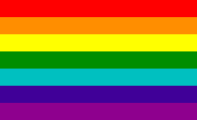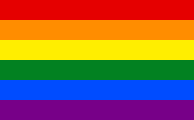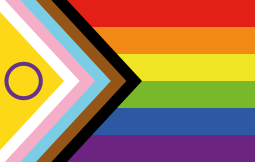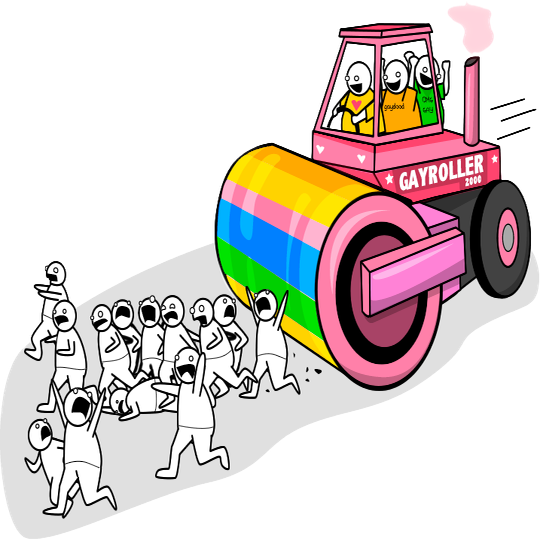The rainbow flag or pride flag is a symbol of LGBT pride and LGBT social movements. The colors reflect the diversity of the LGBT community and the spectrum of human sexuality and gender. Using a rainbow flag as a symbol of LGBT pride began in San Francisco, California, but eventually became common at LGBT rights events worldwide.
Originally devised by the artists Gilbert Baker, Lynn Segerblom, James McNamara and other activists, the design underwent several revisions after its debut in 1978, and continues to inspire variations. Although Baker's original rainbow flag had eight colors, from 1979 to the present day the most common variant consists of six stripes: red, orange, yellow, green, blue, and violet. The flag is typically displayed horizontally, with the red stripe on top, as it would be in a natural rainbow.
LGBT people and allies currently use rainbow flags and many rainbow-themed items and color schemes as an outward symbol of their identity or support. There are derivations of the rainbow flag that are used to focus attention on specific causes or groups within the community (e.g. transgender people, fighting the AIDS epidemic, inclusion of LGBT people of color). In addition to the rainbow, many other flags and symbols are used to communicate specific identities within the LGBT community.
Variations:
Original Gilbert Baker Design

Inspired by the lyrics of Judy Garland’s Over the Rainbow, and the designs used by other social movements such as black civil rights groups from the 1960s, the Rainbow Flag was created. Baker hand-dyed and hand sewed this flag which flew at the San Francisco Gay Freedom Day in June 1978.
Seven-color version due to unavailability of pink fabric

Following the assassination of Harvey Milk in 1978, many people and organisations adopted the Pride flag that he helped to introduce to the community. The demand was so great for a rainbow striped flag, it was impossible for the 8-stripe design to be made in large quantities. Both Paramount and Baker struggled to obtain the hot pink fabric and so began manufacturing a 7-stripe version.
Traditional Gay Pride Flag

In 1979 the design was amended again. The community finalised this six-colour version and this is now the most familiar and recognisable design for the LGBT flag. Numerous complications over the odd number of stripes, including the desire to split the flag to decorate Pride parades, meant that one colour had to be dropped.
The turquoise and indigo stripes were combined to create a royal blue stripe and it was agreed that the flag should typically be flown horizontally, with red at the top, as it would be in a natural rainbow. This design continued to increase in popularity around the world, being a focal point of landmark decisions such as John Stout fighting for his right to fly the flag from his apartment balcony in 1989.
Progress Pride Flag

In June 2018, designer and activist Daniel Quasar released an updated version of the Pride flag. Combining the new elements of the Philadelphia design and the Transgender flag to bring focus on further inclusion and progress. This new flag added a chevron to the hoist of the traditional 6-colour flag which represents marginalised LGBTQ+ communities of colour, those living with HIV/AIDS and those who’ve been lost, and trans and non-binary persons.
This design went viral and was quickly adopted by people and pride parades across the world. The arrow of the chevron points to the right to show forward movement, while being on the left edge shows that progress still needs to be made for full equality, especially for the communities the chevron represents.
Intersex Inclusive Progress Pride Flag

In 2021, Valentino Vecchietti of Intersex Equality Rights UK adapted the Pride Progress flag design to incorporate the intersex flag, creating the Intersex-Inclusive Pride flag 2021.
The intersex community uses the colours purple and yellow as an intentional counterpoint to blue and pink, which have traditionally been seen as binary, gendered colours. The symbol of the circle represents the concept of being unbroken and being whole, symbolising the right of Intersex people to make decisions about their own bodies.
Megathreads and spaces to hang out:
- 📀 Come listen to music and Watch movies with your fellow Hexbears nerd, in Cy.tube
- 🔥 Read and talk about a current topics in the News Megathread
- ⚔ Come talk in the New Weekly PoC thread
- ✨ Talk with fellow Trans comrades in the New Weekly Trans thread
reminders:
- 💚 You nerds can join specific comms to see posts about all sorts of topics
- 💙 Hexbear’s algorithm prioritizes comments over upbears
- 💜 Sorting by new you nerd
- 🌈 If you ever want to make your own megathread, you can reserve a spot here nerd
- 🐶 Join the unofficial Hexbear-adjacent Mastodon instance toots.matapacos.dog
Links To Resources (Aid and Theory):
Aid:
Theory:


why don't we just have two Prides, Adult Pride and Family Friendly Pride
Because we can't let the no kink at pride nerds win.
Seriously, though, this is a key assimilation vs. liberation thing. Kink, which is to just say people having fun, has always been a thing at pride. The assimilationists want to scrub it, and anything else they deem insufficiently cisheteronormative, so they can respectability politics their way to being unmarked members of the existing status quo. They want to be normal, and they'll throw as many people under as many busses as it takes and never admit to themselves it's a fools errand, and that assimilation is a dead end.
At the end of the day "no kink at pride" is "stop wearing silly costumes that remind the straights you're not one of them", mixed with a lot of christian hegemony sex is bad bs,. In so far as official pride celebrations and parades are even worth saving at this point, it needs to be shut down. Leatherdaddies belong at pride, Raytheon, Target, and the FBI doesn't. That's the conflict, more or less.
The only reasonable argument I've seen is that a lot of people don't consent to being part of or an unwilling spectator of kink. The only question about it at this point is if it's more important to honor the past and history or to welcome queer youth that don't want to see kink.
How many queer youth is there that don’t go to pride because of kink stuff…? I feel like it’s a non-issue. I’m sex adverse and I hate too sexualised conversation and content but kink at pride is so easy to just not interact with.
I think it depends on the event and most events are fine but one or two have a few incidents
Yeah, chuds went wild with the scat fetish thing a couple years ago (few years, last year? Semi recently).
There probably should be a discussion of some sort of a line when it comes to bodily fluids and whatnot, but anyone mad about leather or leashes is just trying to turn pride into prude (no thanks).
The think of the children argument is just pearl clutching, kids self censor a ton of stuff. Oh look at the man wearing a leash, how silly. Unless you tell a kid the person is doing that for sex reasons they won’t know. (Maybe? Not a child expert, but I’ve been told this by people with kids).
Family friendly pride is nonsensical imo because pride is centred around protest. Also police regularly beating up people who protest at pride about topics that are too much against status quo is the biggest reason why pride isn’t family friendly.
Also families who don’t like the kinky stuff at pride can just ignore it? A child will not be ruined after seeing a guy in a leather dog mask and little clothing.
If you actually don't know it's cause the kink community was the only people backing us up 50 years ago